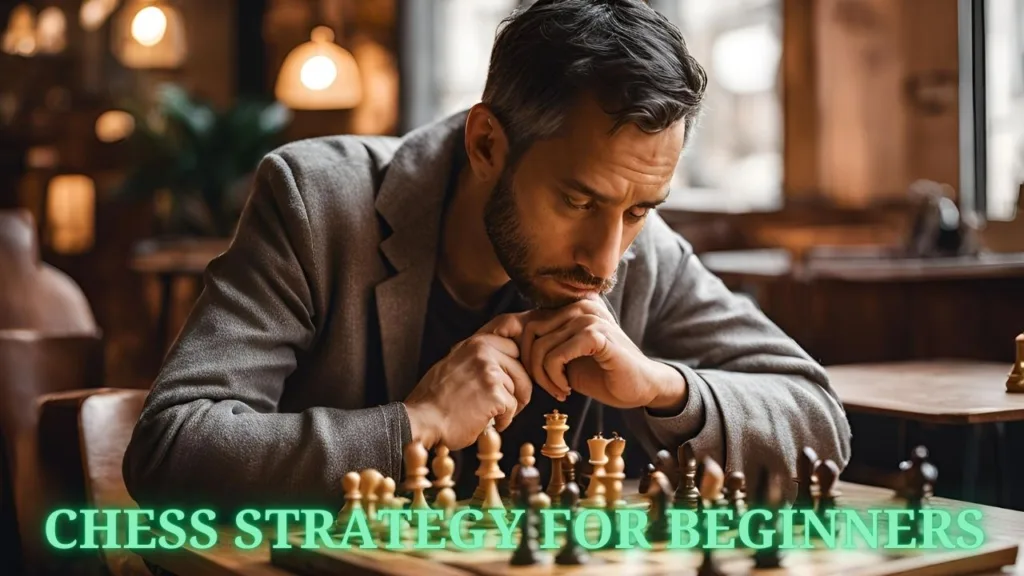Chess isn’t just about moving pieces. It’s about moving the right pieces for the right reasons. Strategy is where the game transforms from a simple pastime into a battle of wits. But here’s the good news: you don’t need to be Magnus Carlsen to learn solid chess strategy.
If you’re new to chess and want to start thinking strategically, this guide is for you. Let’s go beyond random moves and build a plan.
- Rule #1: Control the Center
- Rule #2: Develop Your Pieces
- Rule #3: Protect Your King
- Rule #4: Don’t Lose Material
- Rule #5: Think Ahead
- Rule #6: Create a Plan
- Rule #7: Learn Common Tactics
- Rule #8: Avoid Pawn Weaknesses
- Rule #9: Practice Patience
- Rule #10: Learn from Every Game
- Final Thought: Strategy Is the Heart of Chess
Rule #1: Control the Center
The first thing you’ll hear in chess circles (right after “good luck” or “that was a blunder”) is this: control the center. The four squares in the middle of the board—e4, d4, e5, and d5—are prime real estate.
Why? Because controlling the center gives your pieces freedom to move. Imagine trying to command an army from a narrow alley versus an open field. The center is that open field.
How to Do It:
- Use your pawns to claim the center early. Moves like 1.e4 and 1.d4 are popular for a reason, as they are the first two of the most popular opening moves in chess.
- Develop your knights and bishops toward the center, not the edges.
Rule #2: Develop Your Pieces
A well-placed knight or bishop can be worth more than a rook in some positions. A well-placed queen or rook can end the game. The faster you get your pieces active, the better.
Do:
- Move each piece once to a useful square early on. Knights love f3 and c3. Bishops thrive on c4 and f4.
- Connect your rooks by castling and clearing out the back rank.
Don’t:
- Move the same piece repeatedly without a reason. This is called “piece shuffling,” and it wastes time.
- Bring out your queen too early. It’s tempting, but it will just get chased around like a scared cat.
Rule #3: Protect Your King
Your king isn’t just another piece—it’s the crown jewel. Lose it, and the game’s over. That’s why castling is your best friend.
When to Castle:
- If you’re being attacked: Castle.
- If you’re not being attacked: Still castle.
Which Side?
- Kingside castling is safer.
- Queenside castling is aggressive. If you’re feeling bold (or reckless), give it a shot.
Rule #4: Don’t Lose Material
In chess, every piece is valuable. Losing a pawn might not seem like a big deal, but it adds up. If you keep giving pieces away, your opponent will steamroll you.
Follow the Points of Pieces system:
- Pawn: 1 point
- Knight/Bishop: 3 points
- Rook: 5 points
- Queen: 9 points
Think twice before trading a rook for a knight.
Golden Rule: If you’re about to make a move, check to see if your piece will be captured. Avoid “hanging” pieces—they’re gifts to your opponent.
Rule #5: Think Ahead
Chess isn’t just about the move you’re making—it’s about the moves your opponent will make in response. Ask yourself:
- What will my opponent do if I play this?
- Am I leaving any of my pieces vulnerable?
- Does this move improve my position?
This might seem overwhelming at first, but start small. Even thinking one move ahead is a step in the right direction.
Rule #6: Create a Plan
Chess is a game of ideas. Moving pieces without a goal is like driving without a destination—you’ll just end up lost.
How to Make a Plan:
- Look at the board. What are the weaknesses? Are there pawns you can attack or squares you can control?
- Think about your best piece. How can you make it stronger?
- Coordinate your pieces. A lone queen is powerful, but a queen backed by a rook is deadly.
Rule #7: Learn Common Tactics
While strategy is about long-term planning, tactics are short-term opportunities to gain an advantage. Here are a few to watch for:
- Forks: Attack two pieces at once. Knights are the masters of this.
- Pins: Freeze an opponent’s piece by threatening something more valuable behind it.
- Skewers: Target a valuable piece, forcing it to move and exposing a less valuable piece behind it.
- Discovered Attacks: Move one piece to unleash another.
Tactics can turn a losing game into a winning one.
Rule #8: Avoid Pawn Weaknesses
Pawns might seem insignificant, but they’re the backbone of your position. Weak pawns can cripple your game.
Common Pawn Mistakes:
- Moving too many pawns early, leaving your king exposed.
- Creating “isolated pawns” (pawns with no friends on neighboring files).
- Allowing “doubled pawns” (two pawns stacked on the same file).
Strong pawn structure = strong position.
Rule #9: Practice Patience
Chess isn’t a race. Rushing to attack without preparation is a recipe for disaster. Build up your position, improve your pieces, and strike when the time is right.
Remember, some of the greatest games in history were won by players who waited for the perfect moment.
Rule #10: Learn from Every Game
Every chess game—win or lose—is an opportunity to improve. After the game, ask yourself:
- What moves worked well?
- Where did I make mistakes?
- Did I have a plan, or was I just winging it?
Reviewing your games (even if it’s just a quick glance) will help you avoid repeating the same errors.
Final Thought: Strategy Is the Heart of Chess
Learning chess strategy might seem daunting, but it’s what makes the game so rewarding. With practice, you’ll start to see patterns, make plans, and outsmart your opponents.
So grab your board, follow these tips, and start thinking like a strategist. You might not become a grandmaster overnight, but you’ll definitely stop losing to your little cousin.
I’m the senior editor of Attacking Chess, a keen chess player, rated above 2300 in chess.com. You can challenge me or asking questions at Chess.com.


1 thought on “Chess Strategy for Beginners: How to Think Like a Grandmaster”
Comments are closed.